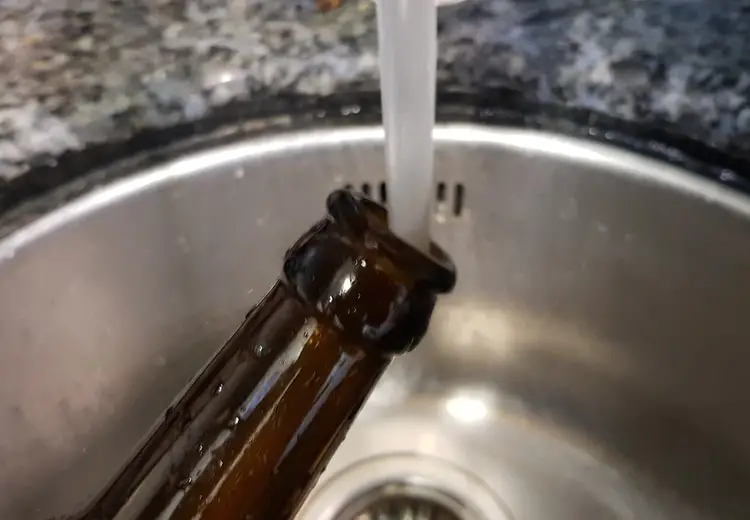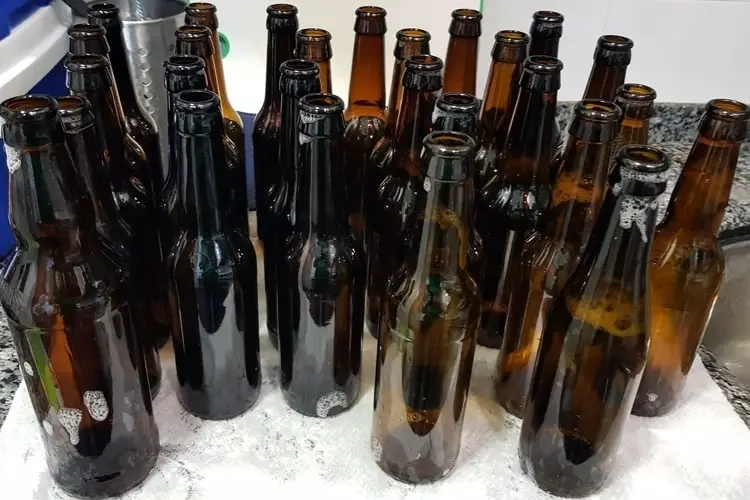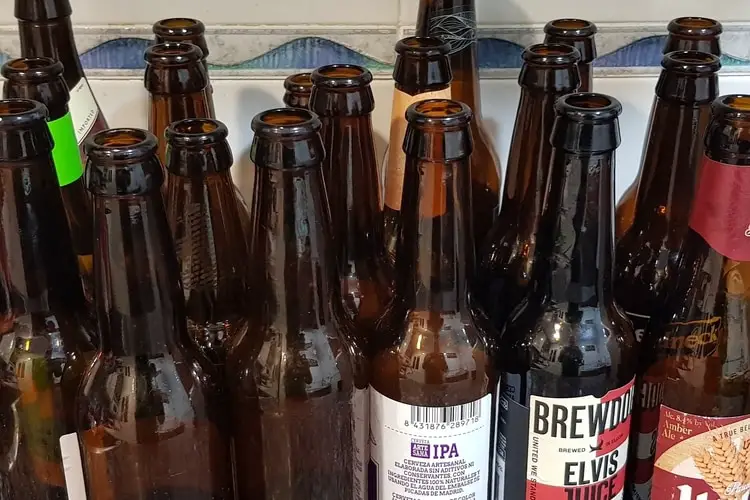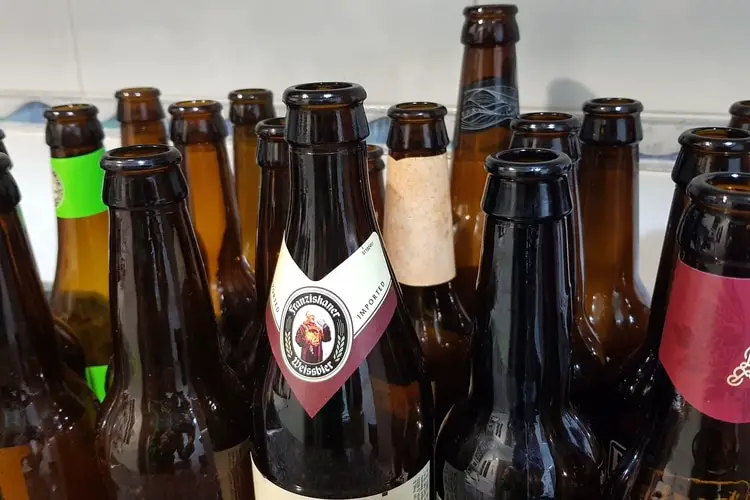Reusing bottles is an easy process once a proper SOP is established. Clean, sanitized bottles are needed for any avid homebrewer. There is no reason to shell out $45.00 for 2 cases of clean bottles each time a batch is packaged. This is almost a dollar a bottle! We’d be better off buying beer at this rate.
Clean cap-able bottles of any sort may be used for bottling beer. Reuse them as long as they stay unchipped and are handled well. Reusing beer bottles from store-bought six packs and from bars is totally fine. Soak, scrub, and sanitize them well.
I will walk you through the steps I took to clean bottles. They were remarkably primitive. It depends on the space and what best fits the brewer’s habits.
Old School Scrubbing – Building Good Habits
Bottling precision is as important as any other brewing facet.
If the brewer is lazy on packaging day, all the previous work and technique precision is for naught.
Make no mistake, it is a chore, and critical to the process.
Firstly, whether store bought beer or homebrew, rinse the bottle as soon as you drink.
Whether using a glass or drinking from the bottle, rinse the bottle right away clearing out the beer and yeast. The bottle is somewhat clean.
When yeast or even just old beer is left in bottles for days or weeks, they can still be cleaned but much harder.

The sanitary rinse and scrub
I had a big shallow ten-gallon fiberglass container which I filled with bleach water.
I mixed it heavy, about 2 fluid ounces for 5 gallons, strong but not enough to eat up your hands.
I put the bottles in and one by one filled to the top and stood them upright and let them sit a few hours. I went about my day.
It will only take 20 minutes to sanitize the bottles but leaving them sit is fine.
Allow me to be crystal clear.
Chlorine needs a 20-minute contact time to kill; cheap effective and slow.
I never bought a new bottle in my life.
I reused my own or occasionally picked them up from bars, who have plenty to spare.
During the soak, all the labels come right off, sweet! Good as new.
After the soak, use a bottle brush and thoroughly scrub the inside of each one. There is always one or two that still have scum in them and a little is ok.
The bleach will loosen it and kill it off.
I will say again, said many times; bleach, any sanitizer, does not clean dirt.
Don’t push it, put clean bottles in the sanitary solution.
Other sanitizers may be used. Bleach was cheap and easy.
Star San is a phosphoric acid sanitizer that is no-rinse as long as it’s used at the correct dilution rate.
B-Brite makes a good pre rinse for dirty bottles, mainly for scrubbing residue, not sanitation.
I lived in the country and had plenty of room.
Final prep
The bottles are ready to use once they are rinsed and dried a bit.
I dumped all the bottles out and brought them into the house keeping the mouths of the bottles clean, exposed to air, but not touching anything else.
I had well water. I brewed and rinsed with it and considered it sanitary. I rinsed bleach three times.
If I could go back, I would buy a faucet bottle washer adaptor, but I was obstinate and did things the hard way.
I set the bottles on paper towels to dry, balanced on their mouths.
Precarious? Yes, and a few times I did have tumbling dominoes of bottles all over the kitchen counter and floor.
I did not invest in a bottle tree (rack for draining and drying bottles).
There are a multitude of field-tested money-saving tips in the article, Homebrewing on a Budget: 7 Tips to Saving Money.

The bottling process
This isn’t the time nor place to get into the bottling itself. Again, as tedious as it might be, it is as integral to brewing as mashing, boiling and any other process.
I do hold forth on the virtues of bottling buckets in the article, Is a Bottling Bucket Necessary, Why or Why Not?
I will remind everyone to keep agitation and bubbling to a minimum to avoid oxidation, prime properly and leave adequate headspace in the bottle; about 1”.
Alternative cleaning methods
The above was the routine I settled into. I had a small kitchen but a big porch for soaking and scrubbing.
In this case, the compact kitchen was a benefit as I could sit in one spot, grab a sanitized bottle, turn, fill, and file the bottles in case boxes.
Using a Standard Kitchen Dishwasher and Other Chems
My brother, brewing partner and mentor Sam used an above standard kitchen dishwasher appliance possibly purchased from the L. Ron Hoover, First Church of Appliantology. I will double check that. I do know it had extra features and devices.
Folks don’t realize this, but dishwasher detergent is not a soap. It is an alkaline cleaner that cleans organic matter by sheeting.
So repeating rinsing chemically scours off the outside residue and to some degree inside the bottle, though not designed for that.
Now… the unique feature of this was that it had a heating element that dried the dishes.
I believe but cannot promise it got up to 170˚ F (76° C).
I’ll go out on a limb and say it did.
For a long slow burn – about 30 minutes – this was an acceptable pasteurization temp, killing any bugs that were still hanging around.
Now Sam was a thorough cleaner within his brewing realm, so he did dunk and shake with no-rinse sanitizer like Star San, and dry the bottles on a bottle tree before filling.
Iodophor is a solid sanitizer, preferred by commercial brewers.
In low amounts it is no rinse but be careful! If you do leave residue it leaves a metallic taste.
Both of these cleaners need 30 – 60 seconds to work.
Commercial brewing
As a commercial brewer I sanitized with peracetic acid.
Now this is a very volatile cleaner and will burn you.
Diluted and handled properly, it is an excellent, strong, fast, no rinse sanitizer; 15 – 20 seconds contact time.
It is harsh though and while you may have a buddy at a brewpub hook you up – careful, it is harsh!
Notes About Getting Bottles
I’ve traveled a bit, Southeast Asia, Africa, even live overseas and seen a lot of garbage.
Recycle bottles.
Short of abusing them and slamming them together, there is no reason they cannot be used 6 -12 times.
If there aren’t enough store-bought passing through the house, ask friends to save them, or your favorite bartender.
Again, in the article Homebrewing on a Budget, I mentioned pop-stopper bottles. If they still sell Fischer or Grolsch in America, just give your local barkeep a nice tip a time or three. He’ll save them for you.

Reuse Your Beer Bottles for Your Homebrews
Some brewers are fastidious and need new bottles. Others keg, use bombers or drink out of these brew – ferment – tap all-in-one setups.
Recycle the bottles, rinse immediately after use, and do your part to reduce waste.
Every quarter saved on glass is another quarter put towards malt, yeast, and hops.
Bottling is tedious and mind numbing. It is also as critical as any process within brewing. Embrace it, take great care and hell, enjoy it!

